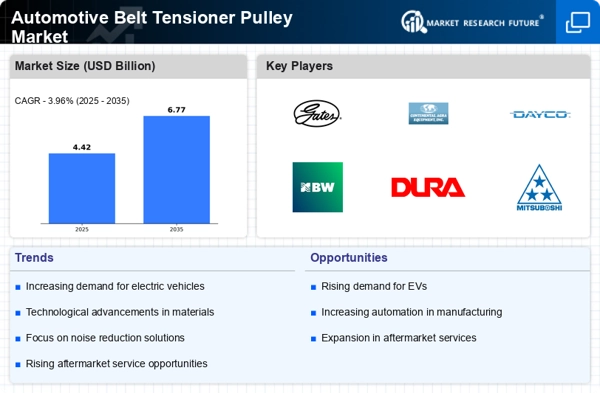Rising Vehicle Production
The automotive industry experiences a consistent increase in vehicle production, which directly influences the Automotive Belt Tensioner Pulley Market. As manufacturers ramp up production to meet consumer demand, the need for efficient engine components, including belt tensioner pulleys, escalates. In 2023, vehicle production reached approximately 80 million units, indicating a robust market for automotive parts. This trend is expected to continue, with projections suggesting a compound annual growth rate of around 3% through 2028. Consequently, the Automotive Belt Tensioner Pulley Market is likely to benefit from this growth, as more vehicles on the road necessitate the replacement and installation of these critical components.
Growing Aftermarket Demand
The aftermarket segment for automotive parts is witnessing substantial growth, which is beneficial for the Automotive Belt Tensioner Pulley Market. As vehicles age, the need for replacement parts increases, particularly for components that experience wear and tear, such as belt tensioners. In 2023, the aftermarket for automotive components was valued at over 400 billion, with projections indicating a steady growth trajectory. This trend suggests that as more vehicles require maintenance and repairs, the demand for high-quality belt tensioner pulleys will rise. Consequently, the Automotive Belt Tensioner Pulley Market is poised to capitalize on this expanding aftermarket, providing opportunities for manufacturers and suppliers alike.
Regulatory Compliance and Standards
The automotive industry is subject to stringent regulations regarding emissions and safety, which significantly influences the Automotive Belt Tensioner Pulley Market. Compliance with these regulations necessitates the use of high-quality components that meet specific performance standards. As governments worldwide implement stricter environmental policies, manufacturers are compelled to innovate and improve their products. This regulatory landscape creates opportunities for the Automotive Belt Tensioner Pulley Market to develop advanced tensioner systems that not only comply with regulations but also enhance vehicle performance. The ongoing evolution of these standards is likely to drive demand for innovative solutions in the market.
Increased Focus on Engine Efficiency
The automotive sector is increasingly prioritizing engine efficiency, which significantly impacts the Automotive Belt Tensioner Pulley Market. Manufacturers are striving to enhance fuel economy and reduce emissions, leading to the development of advanced belt tensioner systems. These systems are designed to optimize the performance of serpentine belts, thereby improving overall engine efficiency. According to industry reports, vehicles equipped with high-performance belt tensioners can achieve fuel savings of up to 5%. This focus on efficiency not only drives demand for innovative tensioner designs but also positions the Automotive Belt Tensioner Pulley Market as a critical player in the broader context of sustainable automotive engineering.
Technological Innovations in Manufacturing
Technological advancements in manufacturing processes are reshaping the Automotive Belt Tensioner Pulley Market. Innovations such as 3D printing and advanced materials are enabling manufacturers to produce lighter, more durable, and cost-effective tensioner pulleys. These innovations not only enhance product performance but also reduce production costs, making it easier for companies to compete in a crowded market. Furthermore, the integration of smart technologies into automotive components is likely to drive the development of intelligent belt tensioners that can monitor performance in real-time. As these technologies evolve, the Automotive Belt Tensioner Pulley Market stands to benefit from increased efficiency and product differentiation.


















Leave a Comment